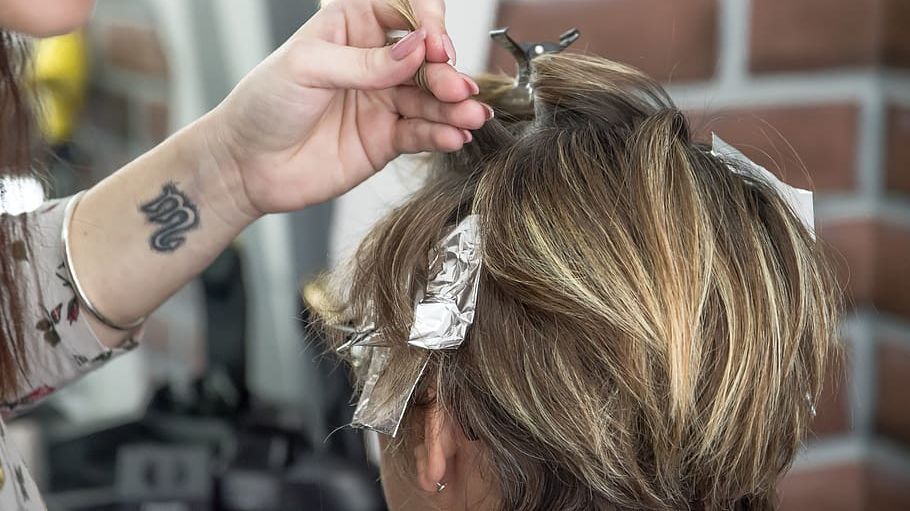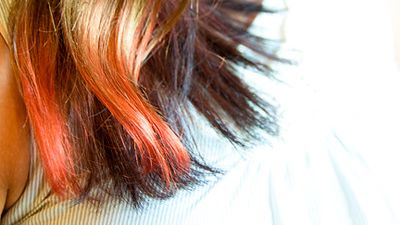Hair Dye

There is not enough information to determine whether hair dye is completely risk-free during pregnancy, or which type of dye may pose the least amount of risk.
Although some animal and very limited human studies have shown potential adverse associations with hair dye and pregnancy, quality evidence is lacking and more research is needed. However, it is currently not expected that the chemicals used in hair dye – when properly applied – are absorbed at a rate high enough to reach the placenta or fetus.
If pregnant women choose to dye their hair, there are several absorption “risk reduction” steps they can take that may eliminate some possible risk, to include through the skin and inhalation.
However, these are largely anecdotal and have not been shown to actively reduce any dermal penetration or contact, especially since science does not know which aspect of hair dye is potentially harmful.
Background
The potential for hair dyes to present a risk during pregnancy is a common concern, but studies during pregnancy are very limited and conflicting. Hair dye is usually absorbed through the scalp and into the body, which has been identified through urine tests.
However, there have been no studies attempting to determine if any components of hair dye can be detected in the fetus or placenta.
Temporary hair color dye: cannot penetrate the cuticle layer and disappears with the first hair wash, usually lasting one week
Semi-permanent hair dye: partially penetrates the hair shaft; lasts about 4 to 12 shampoos; usually consists of coal tar dyes
Permanent color hair dye: penetrates through the hair shaft and enters the skull cortex; contains a developer or oxidizing agent and alkalizing agent ammonia

Temporary and semi-permanent hair does not require chemical reactions necessary to lay down permanent color, and relies mostly on temporary adhesion. In contrast, permanent color is infused into the hair shaft rather than just “painted” over; this infusion can cause hair shaft damage with repeated colorings.
Developers contain hydrogen peroxide which causes swelling of the hair cuticle. This allows for diffusion of the precursor into the hair cortex which bleaches the natural pigment; the colored molecules are then absorbed by the hair cortex.
Pregnancy
The safety of hair-coloring agents is controversial. In general health, some studies have linked these agents to cancer, while others have claimed they have no systemic effects, except for possible allergic reactions.
Research on the use of hair dye during pregnancy is even more limited and inconsistent.
Hair dye as a whole is difficult to study because different types of hair dye contain various ingredients and chemicals. Further, the amount of hair dye which is absorbed through the skin can vary depending on:
Sex, age, and overall health of individual
Type of dye
Dye color
Dye moisture content and concentration
Length of time dye sits on scalp
Environmental conditions

Several adverse effects have been documented in animal studies, and human studies have indicated a moderately increased risk of neuroblastoma, leukemia, and developmental disabilities in offspring of mothers who dyed their hair during pregnancy. However, different types of dyes were used, and many other factors were not differentiated, such as those above.
Studies such as these have led some researchers to advocate avoidance of hair dye during pregnancy, or at least in the first trimester until further research is completed.
It is also possible other unknown components of hair dye need to be considered, as the neuroblastoma finding was associated with temporary hair dye, not permanent, which was unexpected.
It is assessed that although chemicals in hair dye caused adverse pregnancy outcomes in animal studies, since high doses were used, it is not expected that these chemicals can reach the placenta or the fetus in the human doses used during a proper coloring by a professional.
Further, although also limited, studies regarding pregnancy-related outcomes on salon workers have not found adverse associations with the application of hair dye (i.e. fume exposure), and those that have indicated the evidence is currently very weak.
However, although there is no high-quality evidence regarding which dyes may pose the most risk; overall, evidence points toward a more increased risk with darker colors along with increased number of exposures.
Action
Anecdotal methods for hair dye risk reduction are not based on evidence since this has not been studied; however, any method that lessens possible absorption and exposure can be considered best practice until more research is completed.
Waiting to dye hair until at least the second trimester is considered the most effective risk reduction step for any chemical, medication, or activity for which there is a lack of safety data in pregnancy.
Women should use a specialist or a hairstylist at a salon who can apply more complex colors/processes in a professional setting; women should also always advise their hairstylist they are pregnant.
Women should consider applying dye to the tips of the hair, or simply highlighting/frosting and avoiding the scalp all together. Highlights also lessen fume exposure compared to dying all hair.
If women want to dye hair close to the scalp, they should consider adding petroleum jelly to the scalp prior to dye application; petroleum could block dye absorption by placing a barrier between the dye and scalp.

Pregnant women should wash their hair frequently after dying it, as this can reduce possible adverse effects of any toxic chemicals on the fetus; rinsing the hair reduces the chance these chemicals penetrate through the skin and into the bloodstream.
Although this may be the last thing women want to do after dying their hair, it may be the best "middle" option during pregnancy.
Pregnant women who use at-home hair dye should wear gloves during application, apply the dye in a well-ventilated room, avoid inhaling fumes as much as possible, and should not leave dye on the scalp for a longer period than recommended in the instructions.
Read more detailed information related to general hair changes during pregnancy.
Resources
Safety of hair products during pregnancy (Can Fam Physician. 2008)